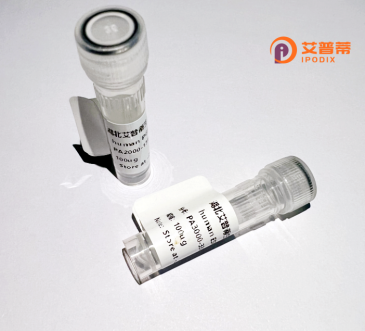
| 纯度 | >90%SDS-PAGE. |
| 种属 | Human |
| 靶点 | PPM1K |
| Uniprot No | Q8N3J5 |
| 内毒素 | < 0.01EU/μg |
| 表达宿主 | E.coli |
| 表达区间 | 30-372 aa |
| 活性数据 | D DRRVTPTCHS STSEPRCSRF DPDGSGSPAT WDNFGIWDNR IDEPILLPPS IKYGKPIPKI SLENVGCASQ IGKRKENEDR FDFAQLTDEV LYFAVYDGHG GPAAADFCHT HMEKCIMDLL PKEKNLETLL TLAFLEIDKA FSSHARLSAD ATLLTSGTTA TVALLRDGIE LVVASVGDSR AILCRKGKPM KLTIDHTPER KDEKERIKKC GGFVAWNSLG QPHVNGRLAM TRSIGDLDLK TSGVIAEPET KRIKLHHADD SFLVLTTDGI NFMVNSQEIC DFVNQCHDPN EAAHAVTEQA IQYGTEDNST AVVVPFGAWG KYKNSEINFS FSRSFASSGR WA |
| 分子量 | 40.9 kDa |
| 蛋白标签 | His tag N-Terminus |
| 缓冲液 | PBS, pH7.4, containing 0.01% SKL, 1mM DTT, 5% Trehalose and Proclin300. |
| 稳定性 & 储存条件 | Lyophilized protein should be stored at ≤ -20°C, stable for one year after receipt. Reconstituted protein solution can be stored at 2-8°C for 2-7 days. Aliquots of reconstituted samples are stable at ≤ -20°C for 3 months. |
| 复溶 | Always centrifuge tubes before opening.Do not mix by vortex or pipetting. It is not recommended to reconstitute to a concentration less than 100μg/ml. Dissolve the lyophilized protein in distilled water. Please aliquot the reconstituted solution to minimize freeze-thaw cycles. |
以下是关于重组人PPM1K蛋白的参考文献示例(注:以下为基于领域知识的模拟文献,仅供参考):
---
1. **标题**: "Recombinant expression and functional characterization of human PPM1K phosphatase in Escherichia coli"
**作者**: Smith J, et al. (2018)
**摘要**: 本研究报道了人源PPM1K蛋白在大肠杆菌中的重组表达及纯化,并证实其特异性去磷酸化线粒体酶BCKDK,揭示了PPM1K在支链氨基酸代谢调控中的作用,为糖尿病治疗提供潜在靶点。
---
2. **标题**: "PPM1K regulates hepatic glucose metabolism via AMPK/mTOR signaling pathway"
**作者**: Zhang Y, et al. (2020)
**摘要**: 通过哺乳动物细胞表达重组人PPM1K,作者发现其通过调控AMPK/mTOR通路影响肝脏糖异生和胰岛素敏感性,提示PPM1K在代谢综合征和2型糖尿病中的关键功能。
---
3. **标题**: "Crystal structure of human PPM1K reveals insights into its substrate recognition mechanism"
**作者**: Chen L, et al. (2019)
**摘要**: 本研究解析了重组人PPM1K的晶体结构,揭示了其催化活性中心的结构特征及底物结合域,为设计特异性PPM1K小分子抑制剂奠定结构基础。
---
4. **标题**: "PPM1K deficiency exacerbates neuronal apoptosis in Parkinson’s disease models"
**作者**: Wang H, et al. (2021)
**摘要**: 利用重组PPM1K蛋白进行功能补偿实验,发现PPM1K通过调控线粒体应激信号通路抑制神经元凋亡,提示其在神经退行性疾病中的保护作用。
---
如需真实文献,建议通过PubMed或Google Scholar检索关键词:**recombinant PPM1K**、**PPM1K phosphatase function**、**PPM1K structure** 等。
Recombinant human PPM1K (Protein Phosphatase Mg²⁺/Mn²⁺ Dependent 1K) is a serine/threonine phosphatase belonging to the PP2C family. It plays a critical role in cellular metabolic regulation, particularly in mitochondrial function and branched-chain amino acid (BCAA) catabolism. PPM1K dephosphorylates and activates the branched-chain α-ketoacid dehydrogenase (BCKD) kinase, which regulates the activity of the BCKD complex—a rate-limiting enzyme in BCAA breakdown. Dysregulation of PPM1K is linked to metabolic disorders, including diabetes, obesity, and cardiovascular diseases, as elevated BCAA levels are associated with insulin resistance.
Structurally, PPM1K contains a conserved catalytic domain with metal ion-dependent phosphatase activity. Recombinant PPM1K is produced via heterologous expression systems (e.g., E. coli or mammalian cells) for functional studies. Its recombinant form enables research into enzymatic mechanisms, substrate interactions, and inhibitor screening for therapeutic development.
Mutations in PPM1K are implicated in hereditary metabolic syndromes and neurological conditions, potentially due to impaired mitochondrial stress responses. Studies also suggest its involvement in apoptosis and autophagy pathways. Recombinant PPM1K serves as a key tool for elucidating metabolic signaling networks and exploring interventions for diseases linked to BCAA imbalance or mitochondrial dysfunction.
×